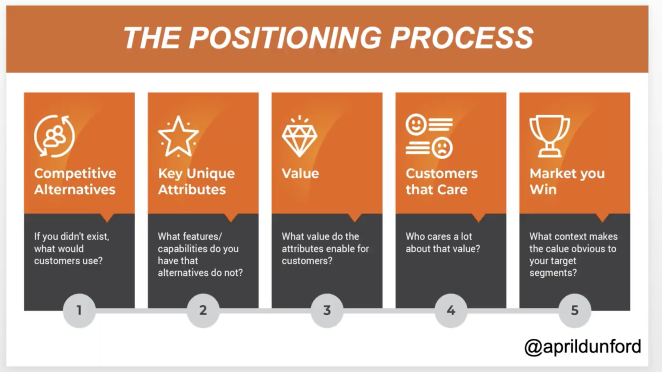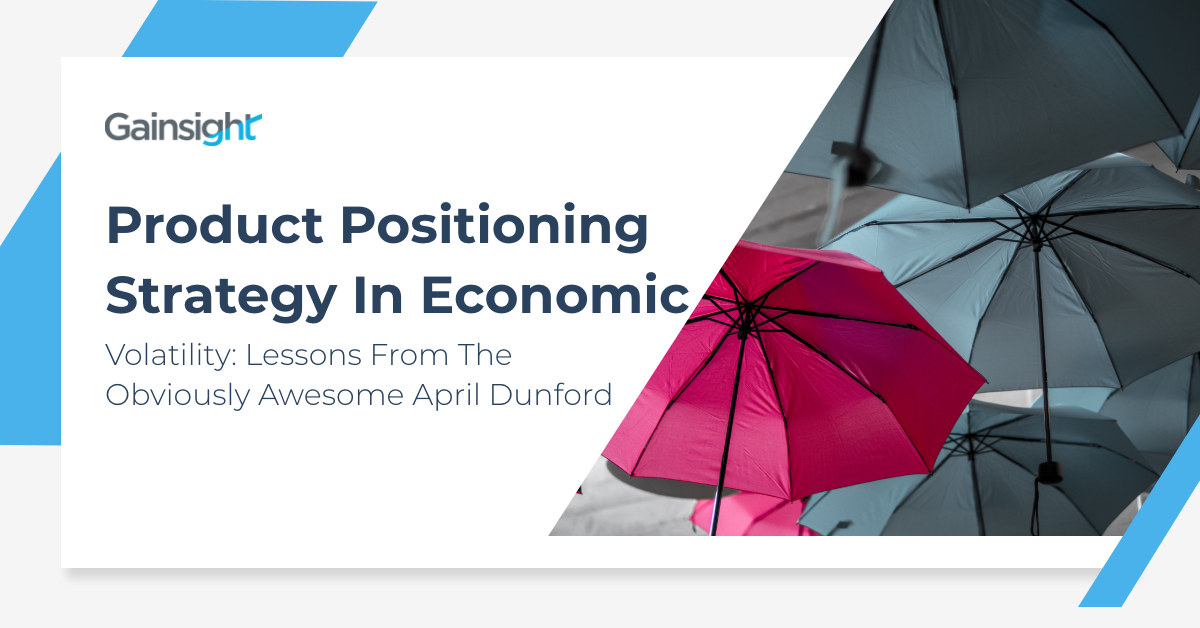It began with a question. April Dunford sat in the back of a marketing class at Northwestern University in Chicago, where her professor gave an example of a product positioning statement. April described it as a “Mad Libs” fill in the blank exercise.
If my product IS a (blank) and my competitors are (blank), then I’m a (blank), UNLIKE (blank) that does or PROVIDES (blank), and this is my benefit (blank).
By filling in the appropriate answers, you would design a product positioning statement that would suffice for your product and company. April studied the example and then posed a question that resulted from recent experience where the database solution her employer sold was identified as a business intelligence tool or a data warehouse. She realized that the strategy for marketing the product changed, as did their field of competition.
When April recounted what transpired, she asked the professor, “If my product can be positioned in multiple different market categories, how do I know which is the best one?” Waiting for the profound answer, the professor leaned in and said, “Look, April, trust me, you’ll just know.” It was then that April realized nobody knew how to answer the question or create a formal marketing positioning statement.
The concept of product positioning sent product marketing expert, April Dunford, on a career-long quest she captured in her book, “Obviously Awesome: How to Nail Product Positioning, so Customers Get It, Buy It, Love It.” Recently, April sat with Ryan Toben, Senior Vice-President and General Manager for Gainsight in EMEA, and Mickey Alon, Gainsight’s Chief Technology Officer, to discuss product positioning, especially during an economic downturn.
What Product Positioning Is and Is Not
“Positioning is an interesting concept,” April stated. “It’s not a new concept, but it is frequently, and I would say tragically misunderstood. So, whenever I talk about positioning, unfortunately, I have to start by talking about what positioning is not.” According to April:
- Positioning is not a tagline.
- It isn’t your viewpoint on the market.
- It isn’t the same thing as messaging, which is a common misconception.
- Positioning is not brand positioning. They are two separate things.
To April, positioning defines how your product is the best at providing something meaningful and unique to a well-defined set of customers. She describes positioning as art that consists of many pieces that need to be broken down and identified. But with which piece do you begin?
For a long time, April thought there was no starting point—like a spiral. You pick something, work around it, and try it. If it doesn’t work, throw it out, and try something else. That is when April discovered The Positioning Process. She placed Comparative Alternatives at the beginning of the process. April thought it was important to ask, “What would the customer do if my thing didn’t exist?” needed to be answered first and be the cornerstone of the process. That led to placing every other component in order.

The components of The Positioning Process are:
- Competitive Alternatives: You must begin with Competitive Alternatives and ask, “What would the customer do or use if my product didn’t exist?”
- Key Unique Attributes: What can your product deliver for customers and customer segments, such as features and attributes. Now, compare them to a competitive alternative.
- Value: What is the value you deliver? The unique value that your product can provide depends entirely on the unique features or attributes. Those two things are dependent.
- Customers that Care: To whom are you selling? For whom is the product? That is your customer segmentation. These are the part of the customer base who are the best fit for your product, and they care about the value you can deliver.
- The Market you Win: aka The Market Category. This product value makes sense to those people. They are your target segments.
Now, when breaking the process apart, the complexity of positioning becomes apparent. The problem is that each component has a relationship with the other. They flow from one to the next.
April summarized it all by saying, “If I wanted to position this product in a context, what I’m looking for is the context that makes that value obvious to these target customers. So, if everything has a relationship with each other, where do we start? Once you discover who the product is for and the parts are apparent, then the positioning becomes apparent as well.”
The process comes with a caution, according to April. “How people usually mess up is the first step—competitive alternatives. So they’re generally thinking about competitors. The competitive alternatives to what we do are often things that don’t look like direct competitors. The competitor is often something like ‘do nothing’ or ‘hire an intern to do it.’ If you get the competitive alternative wrong, then everything downstream is wrong.”
Positioning During an Economic Down Turn
Currently, the pertinent question to ask is, “How does product positioning change when the economy changes?” According to April, you have to realize there is an intuitive understanding of positioning. It is not a static thing. “It’s not the sort of thing that you get just to set it and forget it,” April explained. “The reason you can’t is that everything which impacts positioning is constantly changing.”
Features can be added to your product that make more sense in a different market context, which would require repositioning. That’s not the only thing changing. Your competitors are changing. They’re adding new capabilities, removing items, and, thus, the comparison between you and your competitors is altered.
Numerous internal and external aspects could change. One internal force is a big competitor could move into your market. There are also external forces, the hardest to predict. These would be government regulations or, what we see now, a sudden economic change. The result is a rapid shift in customer behavior and customer priorities.
Being Grounded in Your Customer
During a crisis, it is necessary to protect your customer base and respond to their reactions to current economic issues. How you respond should be based on what your customers are doing to counter internal and external forces. You must be tied to your customer. April explained that when there is a sudden change in the economy, you will see a swift shift in customer priorities. It can be a positive or a negative change depending on the industry.
A prime example is how the current COVID-19 pandemic has negatively affected the travel and entertainment industries. For the most part, those companies are working very hard to ensure that they help their customers stay alive. Then other parts of the economy are growing exponentially, like the health care business. Their biggest challenge right now is how do we go faster? However, most companies are sitting somewhere in the middle. Some of their customers are trying to go more quickly, and some of their customers have slowed down. April’s advice? “The only way we’re going to be able to figure this out is we need to be very close to our customers right now so that we can figure out how their priorities are shifting. And how we need to react to that.”
April suggested three main steps of awareness in changing your marketing positioning during this time.
- Shifting priorities can change your perceived value to the customer.
- Pay attention to the customer’s planning timeframe.
- Realize that the customer relationship has never been more important
To accomplish these crucial steps, you must remain incredibly close to the customer.
Listening to the Voice of the Customer
Listening to the voice of the customer can come in various forms. Sometimes, hearing them and knowing their next move are two different things. Both April and Mickey have leadership experience during recessions and advised that it is a combination of metrics, analytics, and personal relationships with customers that work best.
According to Mickey, he believes that the future is changing for the positive. After every economic downturn, there is an opportunity for innovation. Mickey shared that “This period can be a time of transformation and evolution, especially as we process out of it. It is an opportunity to rethink, to invest, to think about positioning, to think about your product offering, and to think about your customers differently.” Any sustainable growth involves a strategy of the entire company. It touches on positioning to understand the way people think. There are two methods recommended by April and Mickey.
Mickey shared that Gainsight PX is being utilized by many companies as a “have to” spend. Gainsight PX is a full experience platform where companies can track customer usage and send relevant messaging depending on a specific user journey. What Gainsight sees in market trends is being reflected in customer usage. Mickey shared some data showing investment shifting to optimize spending, especially in marketing and customer acquisition. One of the principal elements Gainsight is seeing is the optimization in marketing to drive sign-ups and try and accelerate the funnel. These motions align with Product that needs to be ready for trials and freemium demos working remotely.
April suggested something more and in person—a customer advisory board. She sees many of her customers spending time creating, developing, and engaging with customer advisory board members. Companies want to know how their customers react to this downturn, their next steps, and how resources are shifting? If companies can identify a timeframe of that resource shift, they can figure out if their positioning needs to change in response.
According to April, “They’re doing all kinds of creative things because fewer new deals are happening. They’re leveraging their Sales to do more in-depth customer relationship building. Their Marketing and Product teams are spending more time with customers. As for the advisory board, April believed it is a great time to start an advisory board because customers are navigating uncharted waters. For the most part, customers welcome the idea of sitting with a group of peers and hearing what others are doing and how they’re reacting. April advised, however, to choose wisely. You want honesty and instruction. Also, avoid competitors in the same room. Then no one will talk.
Being Connected in Every Way
In times like these, customers have value beyond what they pay us. There are expansions, more products to purchase, licenses, and other forms of income. But do not forget the references, case studies, and word-of-mouth marketing that are so important. That is why keeping your customers close is fundamental and a priority during financially challenging times.
Moving forward, companies cannot grow at all costs. This economic and marketing landscape is changing all the time. People expect sustainability from a financial perspective. As Mickey said, “You cannot go and spend before you prove your efficiency metrics.” Examine your customers, customer experience, customer retention, and the cost of acquiring customers. Realize that the least expensive motion, but the most crucial option is investing in your customers and their retention. For better insights into how your customers are using your product, take a tour of Gainsight PX.

